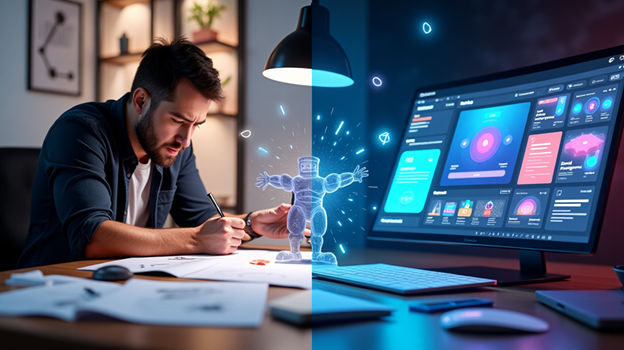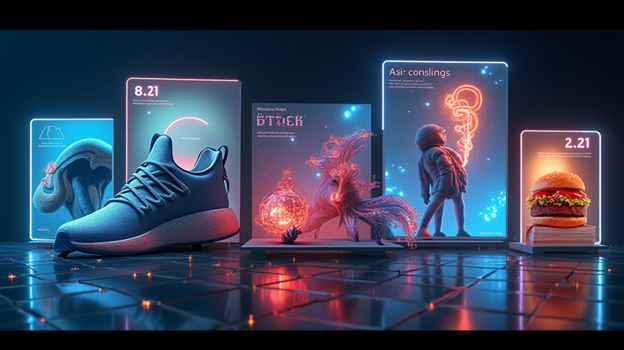In the digital market, visuals speak louder than words. Businesses rely on striking images and graphics to capture attention and convey their brand story. Creating these visuals traditionally required skilled designers, expensive photoshoots, or stock image licenses. Now, artificial intelligence (AI) is changing the game. AI-generated marketing and branding visuals allow companies to produce custom images on demand. This technology cuts costs and boosts creative output while maintaining brand consistency.
Understanding AI Art Generators in Marketing
Recent advances in machine learning have given rise to AI Art generator tools that create images from text descriptions. These AI systems, trained on vast image datasets, can produce everything from product photos to imaginative illustrations with just a prompt.

Marketers are using platforms like ImagineArt, Midjourney, and Stable Diffusion to generate unique artwork aligned with their campaign needs. For instance, instead of using generic stock photos, a marketer can ask an AI to draw a city skyline in the brand’s color palette or imagine a new logo variant.
The result is a tailor-made visual produced in seconds, ready to engage an audience.
Why Businesses Are Embracing AI-Generated Visuals
Companies are rapidly adopting AI for creative tasks because it delivers tangible business benefits. In a recent industry survey, 51% of marketers said they are already using or experimenting with generative AI, and nearly three in four expect to use it soon. Notably, 62% of these marketers use generative AI to generate image assets for campaigns. Several key advantages explain this enthusiasm:
Cost Savings
AI can dramatically reduce the cost of producing marketing graphics. Brands no longer need to budget for numerous photoshoots or endless design revisions. One example is the fintech company Klarna, which claims to have saved millions on marketing by using AI content generation.
Even small businesses benefit, as AI design tools let them create professional-quality visuals in-house at minimal cost.
Speed and Scalability
Marketing teams often face tight deadlines and high content demand. AI image generators work in seconds, enabling rapid content production. This speed lets brands respond to trends or real-time events with timely visuals. It also allows for scaling up creative output – generating dozens of ad variations or social media graphics in minutes.
Personalization and Variety
AI-generated visuals can be tailored to specific audiences or contexts. Marketers can easily tweak an image’s style, colors, or background to appeal to different customer segments. This makes one-to-one marketing at scale possible.
For example, an e-commerce brand could use AI to create product images that reflect each shopper’s preferences (different settings, models, or themes) without manually producing each variant.
Creative Inspiration
AI doesn’t replace human creativity – it augments it. Teams use AI tools to break creative blocks and explore out-of-the-box concepts. An AI might generate a surprising visual idea that a designer can refine and incorporate into a campaign.
Real-World Applications and Case Studies

AI-generated marketing visuals are no longer just experimental novelties; they’re delivering real value in practice. Here are a few real-world examples of how businesses leverage this technology:
Atera’s AI-Only Ad Campaign
Atera, an IT management platform, recently created an entire video advertisement using generative AI tools. The campaign featured fantasy scenes (like office workers floating in space) produced with AI image and video generators, guided by the creative team’s vision. The results were impressive: the project’s timeline shrank from months to just weeks, and the company saved up to $1 million in production costs by using AI.
Major Brands Cutting Costs
Global brands are also seeing ROI from AI visuals. Mondelēz International (parent of Cadbury, Oreo, etc.) has started working with agencies to integrate AI into their ad development. Candy brand Starburst used generative AI to help scale up a major campaign, producing content faster than before. Klarna’s marketing team, as noted, credits AI with significant savings and performance improvements.
Customer Co-Creation
Some brands are using AI art in interactive marketing campaigns. For instance, Reebok launched a tool for fans to design custom sneakers with generative art. Users could submit their own images or themes, and an AI would apply those patterns to a virtual shoe. This not only produced unique digital products for sale but also boosted engagement by involving customers in the creative process.
Democratizing Brand Design
AI is leveling the playing field for branding. Tailor Brands, a startup, uses AI to automatically generate company logos and style guides in minutes. Small businesses that can’t afford a big design agency can now develop a professional logo and visual identity via an AI platform. The AI produces countless logo variations based on the company’s name and preferences, and business owners pick the one that fits best.
Challenges and Considerations
While AI-generated visuals offer exciting benefits, business leaders must approach them with care and strategy. Quality control and brand consistency are top concerns. AI models might create images that look convincing at first glance but include subtle errors or off-brand elements. Marketers need to review and refine AI outputs to ensure they meet brand guidelines and quality standards.
There are also ethical and legal considerations. AI systems learn from existing images on the internet, which raises questions about copyright and originality. Companies must be cautious to avoid infringing on artists’ rights or unintentionally copying another brand’s imagery. Some organizations address this by using AI tools that are trained on licensed or in-house content to stay on the safe side.
Conclusion
AI-generated marketing and branding visuals are revolutionizing content creation. Businesses can now scale up content production, save costs, and personalize campaigns more efficiently. However, AI should be used as an enhancement, not a full replacement, for human creativity. Companies that adopt AI strategically will gain a competitive advantage in delivering visually compelling content that resonates with audiences.

